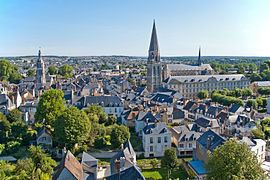Area 23.89 km² Local time Sunday 4:01 AM | Arrondissement Vendôme Time zone CET (UTC+1) Population 16,807 (2007) | |
 | ||
Weather 8°C, Wind W at 6 km/h, 92% Humidity | ||
Vendôme ([vɑ̃dom]) is a town in central France and is a subprefecture of the department of Loir-et-Cher. It is also the department's third biggest town.
Contents
Map of 41100 Vend%C3%B4me, France
It is one of the main towns along the river Loir. The river divides itself at the entrance of Vendôme, intersecting it into numerous different arms. The town has a rich medieval history and many historical monuments.
History
Vendôme (in Latin: Vindocinum) appears originally to have been a Gallic oppidum, replaced later by a feudal castle, around which the modern town arose. Christianity was introduced by Saint Bienheuré in the 5th century, and the important abbey of the Trinity (which claimed to possess a tear shed by Jesus at the tomb of Lazarus) was founded about 1030. When the reign of the House of Capet began, Vendôme formed the chief town of a county belonging to Bouchard, called "the Venerable", who died in the monastery of Saint-Maur-des-Fossés in 1007.
The succession passed by various marriages to the houses of Nevers, Preuilly and Montoire. Bouchard VII, count of Vendôme and Castres (died circa 1374), left as his heiress his sister Catherine, the wife of John of Bourbon, count of La Marche. The county of Vendôme was raised to the rank of a duchy and a peerage of France for Charles of Bourbon (1515); his son Antoine de Bourbon, king of Navarre, was the father of Henry IV, who gave the duchy of Vendôme in 1598 to his illegitimate son César de Bourbon (1594–1665). César, duke of Vendôme, took part in the disturbances which went on in France under the government of Cardinal Richelieu and of Cardinal Mazarin; he was the father of Louis, Duke of Vendôme, who married a niece of Mazarin, and François de Vendôme, Duke of Beaufort. The last of his family in the male line was Louis XIV's famous general, Louis Joseph, duc de Vendôme (1645–1712).
Nominoe, King of Brittany, died undefeated in Vendôme in 851, after conquering the counties of Maine and Anjou.
The comte de Rochambeau, leader of 6,000 French troops in the American Revolutionary War, was born in Vendôme.
Place Vendôme in Paris had been the site of the Hôtel de Vendôme, a mansion which belonged to César de Bourbon, the illegitimate son of Henri IV and his mistress Gabrielle d'Estrées.
Geography
Vendôme is located 22 miles (35 kilometres) northwest of the city of Blois and 40 minutes from Paris by TGV train. The town lies on the Loir River, which here divides into numerous arms intersecting the town.
Administration
Vendôme is the capital of the arrondissement of Vendôme in the Loir-et-Cher department, of which it is a sub-prefecture. It has a tribunal of first instance.
Places of interest
On the south, it is overlooked by an eminence on which stand ruins of the castle of the counts of Vendôme. The abbey-church of the Holy Trinity has a fine façade in the florid Gothic style. Abbey buildings of various periods lie round the church. The church of La Madeleine (15th century) is surmounted by a stone spire, an indifferent imitation of that of the abbey. The tower of Saint-Martin (16th century) represents the vanished church of that name.
Other remarkable monuments are: the old gate, the Porte Saint-Georges; its river front is composed of two large crenelated and machicolated towers, connected by a pavilion, and the ancient hospital of Saint-Jacques that afterwards became a college of the Oratorians, then a lycée for boys and that is now occupied by the town administration offices. The charming chapel, in the most florid Gothic style, is preserved. In the garden surrounding, is located the tourism office in an ancient building called l'Orangerie (facing the public library). The town has a well-known archaeological and scientific society, and possesses a library with more than three hundred manuscripts, and a museum, mostly archaeological, in front of which stands a statue of the poet Pierre de Ronsard. There is also a statue of Marshal Rochambeau, born at Vendôme in 1725. Some interesting houses of the 15th and 16th centuries survive.
